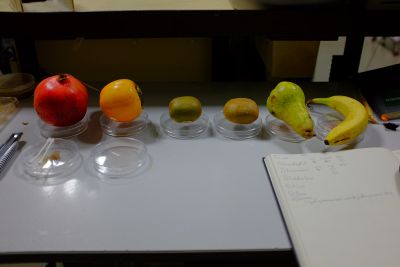The effects of Ethylene Gas on fruits
'One bad apple spoils the bunch' is a saying commonly used to imply that misdemeanants can rub off their negative behaviour onto their nearby peers. However this is also used in a literal sense in that fruits being close to one another causes faster ripening thus bringing faster rotting. This can come as a result of a spreading fungus of some sort but more interestingly as a result of ethylene gas. Ethylene gas is a hormone produced by fruits (and vegetables) and guides the ripening and rotting of them. The gas is released more and less by certain fruits just as much as certain fruits are more and less sensitive to it. Typically released more by more ripe/mature fruits.
Ethylene gas is used to control the maturity of fruits in commercial spaces but cannot be found to order online on mainstream sites from what I've seen. A form of application for the knowledge of fruit-ethylene gas interactions would be a good point to close the topic on.
To raise awareness on fruit storage, to bring tangible evidence of fruit interactions to people and encouraginh positive fruit storage habits. Things such as which fruits to keep together and apart for better ripening or longer preservation. This knowledge of organizing fruits (and vegetables) for preferable outcomes seems limited to the dedicated gardening communities by lack of interest elsewhere but could definitely come in handy for more people. I would think that through photographic representation accompanied by short texts of these ethylene fruit interactions the information would catch more interest. For every person who actively preserves their foods a little bit better there is one less food item that will be thrown out because it looks a little bit overly-ripe. This could an initiative in the direction of environment preservation.
Another potential use for this curious process could be in the field of education. There is a gap between those who have grown up acknowledging and exploring the many intricate interactions that undeniably exist in natural environments, ethylene gas affecting fruits being one of the many, and those who do not see the necessity to pay attention to the more subtle workings of nature. It can become easy to pick sides in that some people dedicate so much to understanding and caring for processes with a minimal effect on the average human life and will be labelled as pretentious. Whereas some refuse the fact that environments on every scale depend upon these many intricate and often unnoticeable to the eye interactions and become ignorant, ostensibly refusing to see how the eradication of a species in a far away forest matters. While many people anchor their beliefs and refuse to learn more, I believe that if
/Root tips:Decay and Passive Absorption
/Ethylene gas and fruit interactions
Credit to this collection of data relating to fruit release rates and sensitivities to ethylene gas that I have used as the foundation for the ethylene segment: https://www.mykitchengarden.info/2016/10/fruits-vegetables-producing-ethylene-or-sensitive.html
